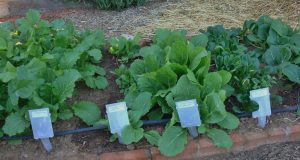 The heat of summer is in full swing, and you probably have things like tomatoes, peppers, and summer squash starting to form in your vegetable garden. Fall seems like it is far away currently, but for gardeners wanting to harvest fall crops, now is the time to start thinking about planting!
The heat of summer is in full swing, and you probably have things like tomatoes, peppers, and summer squash starting to form in your vegetable garden. Fall seems like it is far away currently, but for gardeners wanting to harvest fall crops, now is the time to start thinking about planting!
Vegetable plants that prefer cool weather and that can be harvested in the fall include things like; cabbage, many types of leafy greens, green onions, spinach, bush beans, peas, carrots, broccoli, turnips, and radishes. Plants like this are great for fall gardening, because the seeds can germinate while the soil is warm, and the edible parts of the plant can develop when the weather starts to cool down, which often makes for more delicious produce!
When to plant a certain type of plant depends on the days to maturity of the specific crop. Check the back of your seed packet or do some research and figure out the days to maturity for the crops you want to plant. You will want to add a couple of weeks to that, to account for time to germinate the seeds.
In mid to late July, we have roughly 70-80 days left until we are likely going to get our first frost. This is the time to plant the fall crops that have longer days to maturity. By the time we hit mid-August, we are looking at about 60 days until our first frost. Radishes have very short days to maturity, and they can be planted as late as the first week of September. Many root crops can be left in the ground even after we start getting frosts, but radishes don’t do as well in the ground during cold weather.
What about garlic? This is something you need to think about this fall, but you won’t be harvesting until next summer. Plant garlic cloves around late September to early October. Keep them mulched and watered all winter long, and you will end up harvesting next summer when the leaves start to die down.
Before planting your fall crops, be sure your soil is in good condition to produce another round of veggies. Getting a soil test is always a good idea, but if you are running a little behind on getting your garden going, you can add a few inches of plant based compost and mix that in to your garden soil. Also, consider mixing in some cover crops such as winter rye or something from the legume family (nitrogen fixers!). You will till these in to your soil next spring, they act as a sort of “green manure”.
As you can see, gardening season is no where close to over. It’s time to get out there and start getting ready to have fresh produce coming from your garden until the frosty nights of October are upon us.


